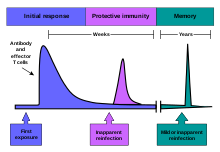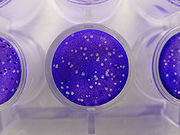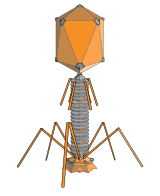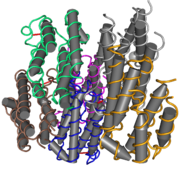The following articles are featured as the Selected article at the Viruses Portal. To suggest an article for inclusion, use the suggestions page
Portal:Viruses/Selected miscellany/1
The Hershey–Chase experiments were conducted by Alfred Hershey and Martha Chase in 1952 using the T2 bacteriophage (pictured), which is composed of DNA wrapped in a protein shell. Hershey and Chase labelled either the phage DNA using radioactive phosphorus-32 or the protein using radioactive sulphur-35. They allowed the radiolabelled phages to infect unlabelled bacteria, and then agitated in a blender and centrifuged to separate material remaining outside the bacterial cells. The majority of the 32P-labelled DNA entered the host bacterial cell, while all the 35S-labelled protein remained outside. Hershey and Chase also showed that the phage DNA is inserted into the bacteria shortly after the virus attaches to its host.
DNA had been known since 1869, but in 1952 many scientists believed that proteins carried the information for inheritance. Proteins appeared more complex, while DNA was thought to be an inert molecule used for phosphorus storage. These experiments built on earlier research on transformation in bacteria and helped to confirm that DNA, not protein, was the genetic material. Hershey shared the 1969 Nobel Prize in Physiology or Medicine for the research.
Portal:Viruses/Selected miscellany/2
Viruses and viral infections have affected human history. Epidemics caused by viruses began when human behaviour changed during the Neolithic period, around 12,000 years ago. Previously hunter-gatherers, humans developed more densely populated agricultural communities, which allowed viruses to spread rapidly and subsequently to become endemic. Viruses of plants and livestock also increased, and as humans became dependent on agriculture and farming, diseases such as potyviruses of potatoes and rinderpest of cattle had devastating consequences. Smallpox and measles viruses are among the oldest that infect humans. They first appeared in humans in Europe and North Africa thousands of years ago, having evolved from viruses that infected other animals. Influenza pandemics have been recorded since 1580.
There are an estimated 1031 viruses on Earth. Although scientific interest in them arose because of the diseases they cause, most viruses are beneficial. They drive evolution by transferring genes across species, play important roles in ecosystems, and are essential to life.
Portal:Viruses/Selected miscellany/3
The history of virology is usually considered to begin in the late 19th century, when the first evidence for the existence of viruses came from experiments using filters with pores small enough to retain bacteria. Dmitry Ivanovsky showed in 1892 that sap from a diseased tobacco plant remained infectious despite having been filtered; this agent, later known as tobacco mosaic virus, was the first virus to be demonstrated. In 1898, Friedrich Loeffler and Paul Frosch showed that foot-and-mouth, an animal disease, was caused by a filterable agent. That year, Martinus Beijerinck (pictured) called the filtered infectious substance a "virus" – often considered to mark the beginning of virology.
Bacteriophages, viruses that infect bacteria, were characterised by Frederick Twort and Félix d'Herelle in the early 20th century. In 1926, Thomas Milton Rivers defined viruses as obligate parasites. Viruses were demonstrated to be particles, rather than a fluid, by Wendell Meredith Stanley, and the invention of the electron microscope in 1931 allowed them to be visualised.
Portal:Viruses/Selected miscellany/4
Vaccination or immunisation is the administration of immunogenic material (a vaccine) to stimulate an individual's immune system to develop adaptive immunity to a virus or other pathogen, and so develop protection against an infectious disease. The active agent of a vaccine may be intact but inactivated or weakened forms of the pathogen, or purified highly immunogenic components, such as viral envelope proteins. Smallpox was the first disease for which a vaccine was produced, by Edward Jenner in 1796.
Vaccination is the most effective method of preventing infectious diseases and can also ameliorate the symptoms of infection. When a sufficiently high proportion of a population has been vaccinated, herd immunity results. Widespread immunity due to mass vaccination is largely responsible for the worldwide eradication of smallpox and the elimination of diseases such as polio from much of the world. Since their inception, vaccination efforts have met with objections on scientific, ethical, political, medical safety and religious grounds, and the World Health Organization considers vaccine hesitancy an important threat to global health.
Portal:Viruses/Selected miscellany/5
A prion is an infectious agent hypothesised to consist of protein. This is in contrast to viruses and other known infectious agents, which all contain one or both of the nucleic acids, DNA and RNA. Prions propagate by transmitting a misfolded protein state. The prion induces existing, properly folded proteins in the host to convert into the misfolded prion form. Abnormal protein aggregates called amyloids accumulate in infected tissue and are associated with tissue damage and cell death.
Prion variants of PrP are associated with the transmissible spongiform encephalopathies in mammals. Human prion diseases include Creutzfeldt–Jakob disease, Gerstmann–Sträussler–Scheinker syndrome, fatal familial insomnia, kuru and variably protease-sensitive prionopathy. Prion diseases of other mammals include bovine spongiform encephalopathy ("mad cow disease") in cattle, scrapie in sheep, and chronic wasting disease in deer. All known mammalian prion diseases affect the structure of the brain or other neural tissue. All are progressive, lack an effective treatment and are inevitably fatal. Proteins showing prion-type behaviour are also found in some fungi. Fungal prions do not appear to cause disease in their hosts.
Portal:Viruses/Selected miscellany/6
The immune system is a system of structures and processes within an organism that protects against disease. It must detect a wide variety of pathogens – from viruses to parasitic worms – distinguish them from the organism's own healthy tissue, and neutralise them. Simple unicellular organisms such as bacteria have enzymes that protect against bacteriophage infections. Other basic immune mechanisms, including phagocytosis, antimicrobial peptides called defensins, and the complement system, evolved in ancient eukaryotes and are found in plants and invertebrates.
Humans and most other vertebrates have more sophisticated defence mechanisms, including the ability to adapt over time to recognise specific pathogens more efficiently. Adaptive immunity creates immunological memory after an initial response to a specific pathogen, leading to an enhanced response to subsequent encounters with that same pathogen. This process of acquired immunity is the basis of vaccination. Viruses and other pathogens can rapidly evolve to evade immune detection, and some viruses, notably HIV, cause the immune system to function less effectively.
Portal:Viruses/Selected miscellany/7
Virus quantification is necessary for viral vaccine production, and is used to manage people infected with HIV, hepatitis B and C, and cytomegalovirus. A wide range of traditional and modern methods are used. Plaque assays (pictured) infect a monolayer of host cells with dilutions of the virus and count the number of holes or plaques, where cells have lysed and infected their neighbours. For viruses that do not lyse their host cell, plaques of cells showing cytopathic effects can be counted or viral proteins can be immunostained with fluorescent-labelled antibodies. These methods quantify infectious virus, while others, such as electron microscopy, return a higher concentration because they count all virus particles, whether or not they are viable. Other assays, such as the haemagglutinin assay, quantify viral proteins.
Often slow and labour intensive, traditional methods have been complemented by modern technologies that greatly reduce quantification time, including quantitative polymerase chain reaction, flow cytometry, enzyme-linked immunosorbent assays and tunable resistive pulse sensing.
Portal:Viruses/Selected miscellany/8
Virus classification is the process of naming viruses and placing them into a taxonomic system. They are mainly classified by phenotypic characteristics, such as morphology, nucleic acid type, mode of replication, host organisms and the type of disease they cause.
Two schemes are in common use. The International Committee on Taxonomy of Viruses (ICTV), established in the early 1970s, classifies viruses into taxa (groups) similar to the biological classification used for cellular organisms, which reflect viruses believed to have a common ancestor. As of 2019, 9 kingdoms, 16 phyla, 36 classes, 55 orders, 168 families, 1,421 genera and 6,589 species of viruses have been defined. Since 2018, viruses have also been classified into higher-level taxa called realms. Four realms are defined, as of 2020, encompassing almost all RNA viruses; some DNA viruses have yet to be assigned a realm.
The older Baltimore classification (pictured), proposed in 1971 by David Baltimore, places viruses into seven groups (I–VII) based on their nucleic acid type, number of strands and sense, as well as the method the virus uses to generate mRNA. There is some concordance between Baltimore groups and the higher levels of the ICTV scheme.
Portal:Viruses/Selected miscellany/9
Bacteriophages (or phages) are a large and diverse group of viruses that infect bacteria and archaea. Their genome, which they inject into the host's cytoplasm, can be DNA or RNA, single or double stranded, linear or circular, and contains between four and several hundred genes. Their capsid can be relatively simple or elaborate in structure, and in a few groups is surrounded by an envelope. Caudovirales, double-stranded DNA phages with tails, is the best-studied group, and includes T4 (pictured), λ phage and Mu phage.
Among the most common entities in the biosphere, bacteriophages are ubiquitous in locations populated by bacteria. One of the densest natural sources is sea water, where up to 900 million virions/mL have been found in microbial mats at the surface, and up to 70% of marine bacteria can be infected.
Used as an alternative to antibiotics for over 90 years, phages might offer a potential therapy against multi-drug-resistant bacteria.
Portal:Viruses/Selected miscellany/10
Plant viruses face different challenges from animal viruses. As plants do not move, transmission between hosts often involves vectors, most commonly insects, but also nematodes and protozoa. Plant viruses can also spread via seeds, and by direct transfer of sap. Plant cells are surrounded by cell walls which are difficult to penetrate. Movement between cells occurs mainly by transport through plasmodesmata, and most plant viruses encode movement proteins to make this possible. Although plants lack an adaptive immune system, they have complex defences against viral infection. Viruses of cultivated plants often cause disease, and are thought to cause up to US$60 billion losses to global crop yields each year; infections of wild plants are often asymptomatic.
Most plant viruses are rod-shaped, with protein discs forming a tube surrounding the viral genome; isometric particles are another common structure. They rarely have an envelope. The great majority have an RNA genome, which is usually small and single stranded. Plant viruses are grouped into 73 genera and 49 families. Tobacco mosaic virus (pictured) is among the best characterised of the 977 species officially recognised in 1999.
Portal:Viruses/Selected miscellany/11
Infectious diseases are symptomatic diseases of an individual host resulting from the infection and replication of pathogens, including viruses, prions, bacteria, fungi, protozoa and multicellular parasites. Infectious diseases were responsible for 17% of human deaths globally in 2013, with HIV, measles and influenza being among the most significant viral causes of death.
Infectious pathogens must enter, survive and multiply within the host, and spread to fresh hosts. Relatively few microorganisms cause disease in healthy individuals, and infectious disease results from the interplay between these rare pathogens and the host's defences. Infection does not usually result in the host's death. The pathogen is generally cleared from the body by the host's immune system, although persistent infection occurs with several viruses. Transmission can occur by physical contact, contaminated food, water or objects, body fluids, airborne inhalation or via vectors, such as the mosquito (pictured). Diagnosis sometimes involves identifying the pathogen; techniques include culture, microscopy, immunoassays and PCR-based diagnostics.
Portal:Viruses/Selected miscellany/12
Reverse transcriptase is an enzyme that generates complementary DNA from an RNA template, in contrast to the usual information flow from DNA to RNA. It was discovered in Rous sarcoma virus and murine leukaemia virus, two retroviruses, by Howard Temin and David Baltimore, working independently in 1970, for which the two shared the Nobel Prize in Physiology or Medicine.
Reverse transcription is essential for the replication of retroviruses, allowing them to integrate into the host genome as a provirus. The enzyme is a target for reverse-transcriptase inhibitors, a major class of anti-HIV drugs. Reverse transcription is also used by Hepadnaviridae and Caulimoviridae, DNA viruses that replicate via an RNA intermediate, such as hepatitis B. The process is important in the movement of retrotransposons, a type of mobile genetic element, and in the extension of chromosome ends in eukaryotic genomes. The enzyme is widely used in the laboratory for molecular cloning, RNA sequencing, polymerase chain reaction and genome analysis.
Portal:Viruses/Selected miscellany/13
Interferons are a group of signalling proteins released by host cells in response to viruses and other pathogens. They belong to a large class of proteins known as cytokines: molecules used for communication between cells to trigger the protective defences of the immune system that help to eradicate pathogens. More than twenty distinct interferon genes and proteins have been identified in animals, including humans.
When a cell is infected by a virus, several virus products, including glycoproteins and viral RNA, stimulate the cell to produce and release interferons. This causes nearby cells to heighten their defences against viral infection, and so interferes with viral replication. Some viruses, including Japanese encephalitis virus, dengue type 2 virus, human cytomegalovirus and Kaposi's sarcoma-associated herpesvirus, have evolved ways to resist interferon's antiviral activity. Interferons also have various other functions in regulating the immune system. Interferons and other cytokines are responsible for some symptoms of infection, such as fever, muscle pain and "flu-like symptoms".
Portal:Viruses/Selected miscellany/14
RNA interference is a type of gene silencing that forms an important part of the immune response against viruses and other foreign genetic material in plants and many other eukaryotes. A cell enzyme called Dicer (pictured) cleaves double-stranded RNA molecules found in the cell cytoplasm – such as the genome of an RNA virus or its replication intermediates – into short fragments termed small interfering RNAs (siRNAs). These are separated into single strands and integrated into a large multi-protein RNA-induced silencing complex, where they recognise their complementary messenger RNA (mRNA) molecules and target them for destruction. This prevents the mRNAs acting as a template for translation into proteins, and so inhibits, or silences, the expression of viral genes.
RNA interference allows the entire plant to respond to a virus after a localised encounter, as the siRNAs can transfer between cells via plasmodesmata. The protective effect can be transferred between plants by grafting. Many plant viruses have evolved elaborate mechanisms to suppress this response. RNA interference evolved early in eukaryotes, and the system is widespread. It is important in innate immunity towards viruses in some insects, but relatively little is known about its role in mammals. Research is ongoing into the application of RNA interference to antiviral treatments.
Portal:Viruses/Selected miscellany/15
A global drive to eradicate poliovirus started in 1988, when there were an estimated 350,000 cases of wild poliovirus infection globally. Two diseases, both caused by viruses, have been eradicated, smallpox in 1980 and rinderpest in 2011. Poliovirus only infects humans. It persists in the environment for a few weeks at room temperature and a few months at 0–8 °C. The oral polio vaccine is inexpensive, highly effective and is predicted to generate lifelong immunity. Reversion of live vaccine strains to virulence has resulted in occasional cases of vaccine-associated polio paralysis.
Two of the three strains of wild-type poliovirus have been eradicated. Annual reported cases of wild poliovirus infection fell to a low of 22 in 2017, but had risen to 176 in 2019. As of 2020, the wild virus remains endemic only in Afghanistan and Pakistan, but vaccine-derived poliovirus is circulating in several countries. A lack of basic health infrastructure and civil war remain significant obstacles to eradication. Some local communities have opposed immunisation campaigns, and vaccination workers have been murdered in Pakistan and Nigeria.
Portal:Viruses/Selected miscellany/16
Bats host a diverse array of viruses, including all seven types described by the Baltimore classification system. The most common viruses known to infect bats are coronaviruses. Bats harbour many viruses that are zoonotic, or capable of infecting humans, including rabies virus, SARS-CoV, SARS-CoV-2, MERS-CoV, Nipah virus, Hendra virus and Marburg virus (hosted by the Egyptian fruit bat; pictured), and some bat-borne viruses are considered important emerging viruses. Bats may also play a role in the ecology of the Ebola virus. Most zoonotic bat viruses are transmitted by direct contact with infected bat fluids such as urine, guano and saliva, or through contact with an infected intermediate host; transmission of rabies from bats to humans usually occurs via biting. Butchering or consuming bat meat could potentially lead to viral transmission.
Bats rarely become ill from viral infections, and rabies is the only viral disease known to kill them. They might be more tolerant of infection than other mammals. Their immune systems differ from those of other mammals in their lack of several inflammasomes, which activate the body's inflammatory response, as well as a dampened stimulator of interferon genes response, which helps to control the host response to pathogens.
Portal:Viruses/Selected miscellany/17
Portal:Viruses/Selected miscellany/17
Portal:Viruses/Selected miscellany/18
Portal:Viruses/Selected miscellany/18
Portal:Viruses/Selected miscellany/19
Portal:Viruses/Selected miscellany/19
Portal:Viruses/Selected miscellany/20
Portal:Viruses/Selected miscellany/20
















